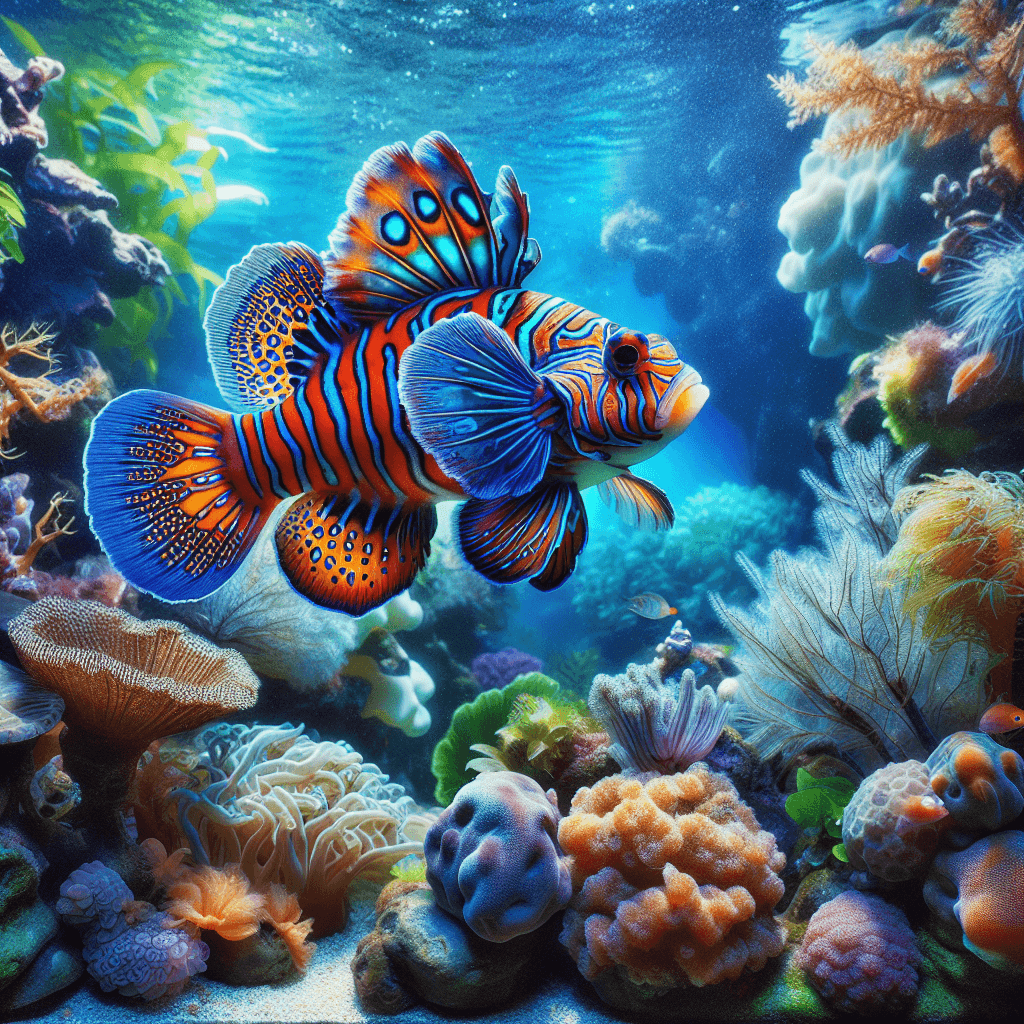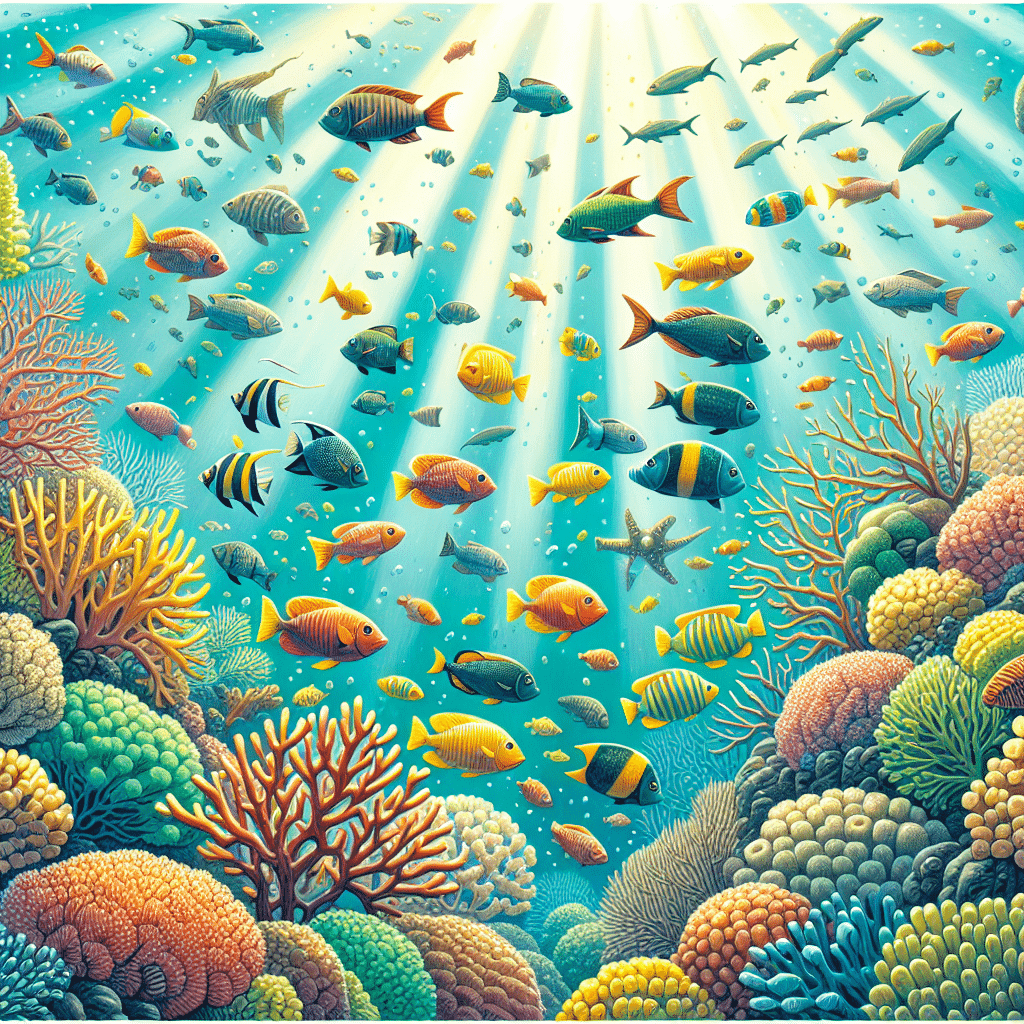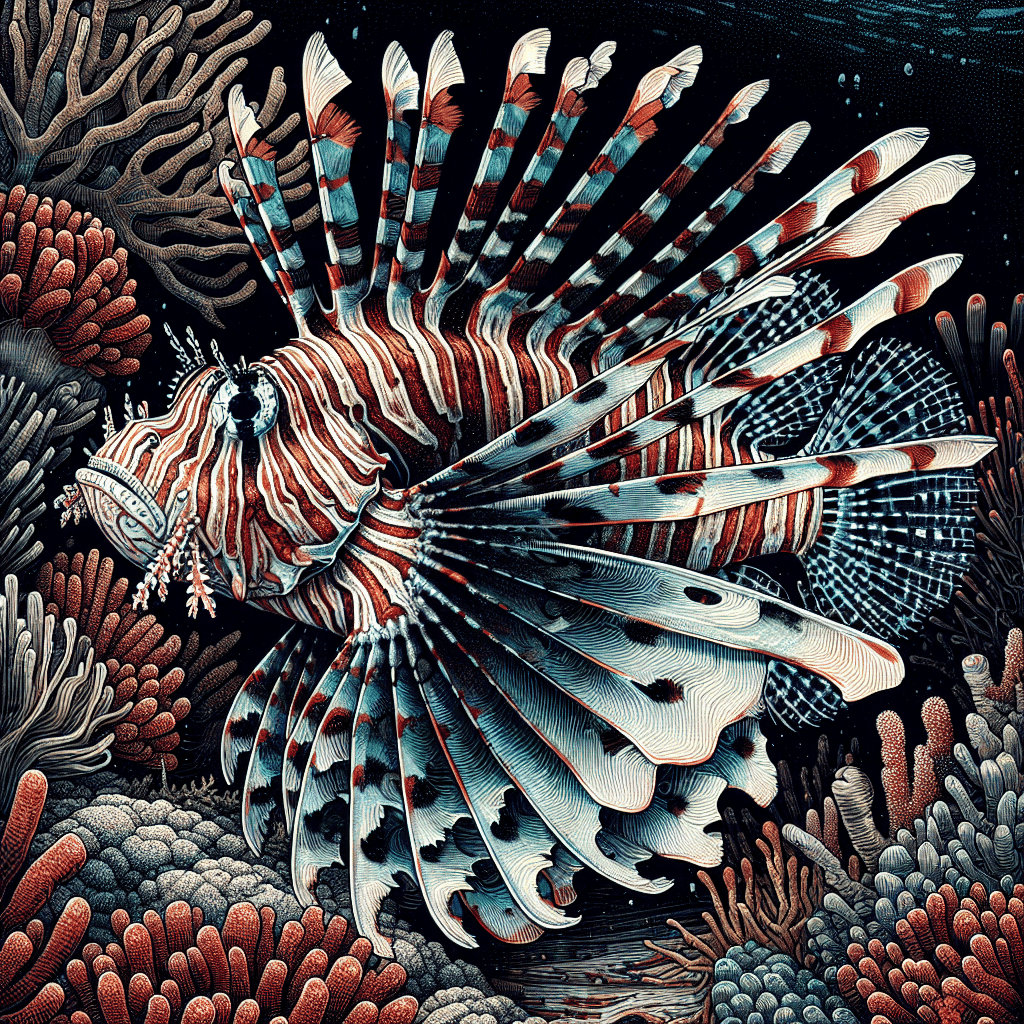The Colorful Mandarin Fish
Introduction to Mandarin Fish
I have always been fascinated by the vibrant beauty of the mandarin fish, known scientifically as Synchiropus splendidus. This small, brightly colored member of the dragonet family is native to the Pacific, ranging from the Ryukyu Islands down to Australia. The mandarin fish is well-known for its striking coloration, which makes it a popular choice among aquarium hobbyists. In fact, it is one of only two vertebrate species recognized to have blue coloring due to cellular pigment, with the other being the psychedelic mandarin (S. picturatus) (Wikipedia).
Physical Characteristics
The physical description of mandarin fish is nothing short of unique. They have a broad, depressed head and are primarily blue, adorned with vibrant orange, red, and yellow wavy lines. These fish are relatively small, reaching a maximum length of about 6 cm, or approximately 3 inches. Interestingly, males tend to be larger than females. One of the notable features of mandarin fish is that they lack scales, which is quite unusual for fish. Instead, they are covered in a thick mucus coating that can emit an unpleasant smell (Animal Diversity Web, Two Fish Divers).
| Characteristic | Description |
|---|---|
| Scientific Name | Synchiropus splendidus |
| Maximum Length | 6 cm (about 3 inches) |
| Coloration | Blue with orange, red, yellow lines |
| Scale Type | Lacks scales, has a mucus coating |
| Additional Feature | Second set of jaws for feeding |
Mandarin fish also possess a second set of jaws, known as pharyngeal jaws, which they use to crush and masticate hard-shelled prey, such as snails and small hermit crabs (TFH Magazine). Their distinctive appearance and unique feeding mechanisms make them an intriguing species to observe in both the wild and in aquariums.
For more information on other exciting marine species, check out our articles on clownfish, seahorse, and grouper.
Habitat and Behavior
Natural Habitat of Mandarin Fish
I find the mandarin fish fascinating, especially when I learn about their natural habitat. These beautiful fish are reef dwellers that prefer sheltered lagoons and inshore reefs. They typically inhabit areas where they can hide among rocks and corals, which helps them feel secure. The mandarin fish can reach a size of about 6 cm, making them relatively small and not easily spotted in the wild (Wikipedia).
Here is a quick overview of their preferred habitat:
| Habitat Type | Characteristics |
|---|---|
| Sheltered Lagoons | Calm waters, abundant hiding spots |
| Inshore Reefs | Rich in biodiversity, shallow areas |
Feeding Behavior
When it comes to feeding, mandarin fish are slow-moving bottom feeders. Their diet mainly consists of small marine organisms. They enjoy a variety of food sources including harpacticoid copepods, polychaete worms, small gastropods, gammaridean amphipods, fish eggs, and ostracods. Based on gut analyses of wild fish, these food items form the backbone of their diet (Wikipedia).
Since they have specific feeding habits, keeping mandarin fish in an aquarium can be a challenge. While some individuals can adapt to aquarium food, many will only eat live amphipods and copepods. This makes it essential for hobbyists to provide them with a proper diet to ensure they thrive in a tank environment. For more information on suitable foods for various fish, check out our article on marine fish.
Here’s a summary of their dietary preferences:
| Food Type | Description |
|---|---|
| Harpacticoid Copepods | Small crustaceans found in sediment |
| Polychaete Worms | Segmented worms often found in sand |
| Small Gastropods | Snails and similar mollusks |
| Gammaridean Amphipods | Tiny shrimp-like crustaceans |
| Fish Eggs | Eggs from various marine species |
| Ostracods | Small bivalve crustaceans |
Understanding the habitat and feeding behavior of mandarin fish is crucial for any fish tank or reef tank hobbyist looking to care for these unique and colorful creatures.
Keeping Mandarin Fish in Aquariums
Challenges of Keeping Mandarin Fish
Keeping mandarin fish can be quite the adventure, but it comes with its own set of challenges. These fish are known for their stunning colors and unique behaviors, but they are also notoriously difficult to maintain in captivity. One of the main issues is their specific feeding habits. While some mandarins may adapt to eating prepared foods, many will only consume live food, particularly small crustaceans like amphipods and copepods. This can make it hard to ensure they receive adequate nutrition (Wikipedia).
Another challenge is that mandarins are sensitive to water quality and environmental changes. They thrive in stable conditions and can be stressed by fluctuations in temperature, salinity, or pH levels. This means that as an aquarium hobbyist, I need to pay close attention to the tank environment to keep my mandarins happy. Furthermore, while they are resistant to certain diseases like marine ich due to their unique skin type, they can still fall victim to other issues if not properly cared for.
Dietary Requirements
Feeding mandarin fish can be a bit tricky, but understanding their dietary needs is crucial for their well-being. Here’s a quick look at what mandarins typically eat:
| Food Type | Description |
|---|---|
| Live Food | Essential for those that won’t adapt to pellets; includes amphipods and copepods. |
| Frozen Foods | Some may accept frozen varieties of live food, but this varies. |
| Prepared Pellets | Captive-bred mandarins may eat high-quality pellets, making them easier to care for. |
Captive-bred mandarins, which have been raised in aquarium conditions, tend to have a higher chance of survival in novice tanks, as they are often more willing to accept pellets (TFH Magazine).
In summary, while keeping mandarin fish can pose some challenges, particularly in feeding, understanding their dietary requirements and providing a stable environment can lead to a rewarding experience. If you’re interested in more information about marine fish, check out our articles on marine fish and other fascinating species like the clownfish or tang.
Breeding Mandarin Fish
Mating Rituals of Mandarin Fish
When it comes to breeding, mandarin fish have some pretty fascinating rituals. These colorful fish are known for their vibrant courtship displays, especially during the mating season. The males typically showcase their bright colors and perform elaborate dances to attract females. This can be quite the spectacle, especially if you’re diving in places like Indonesia where these fish are abundant (Two Fish Divers).
One interesting fact is that green mandarins can spawn up to twice a night, but this frequency is heavily influenced by how well they are fed. When well-fed, they seem to spawn more regularly, anywhere from every night to every three nights (TFH Magazine). Watching them during this time is truly a treat for any reef tank hobbyist.
Reproduction and Larval Development
Mandarins reach sexual maturity at around 14 months of age. This means that if you’re planning to breed them in your aquarium, you’ll need to be patient. Captive-bred mandarins are a better choice for novices, as they typically adapt better to tank life and are more likely to eat pellets, which makes feeding easier (TFH Magazine).
After mating, the eggs are usually laid in the water column, where they drift and hatch into larvae. The larval development stage can be quite challenging, as the tiny mandarin larvae are very delicate and require specific conditions to thrive. It’s crucial to provide a well-maintained environment for them to grow, as survival rates can be low without the right care.
If you’re interested in keeping mandarin fish, understanding their breeding habits and providing the right conditions for both adults and larvae can lead to a successful experience. For more information on marine life and other reef tank fish, check out our articles on marine fish and the various species that might complement your aquarium, like clownfish or wrasse.
Lifespan and Captivity
Lifespan of Mandarin Fish
In the wild, mandarin fish can live quite a long time, typically between 10 to 15 years. However, when I keep them in captivity, their lifespan drops significantly, averaging only about 2 to 4 years. This shorter lifespan is mainly due to their specific dietary needs. They require a diet rich in live foods, which can be challenging to provide consistently in an aquarium setting.
Here’s a quick comparison of their lifespan in different environments:
| Environment | Lifespan |
|---|---|
| Wild | 10 – 15 years |
| Captivity | 2 – 4 years |
Captive-bred mandarins tend to thrive better in home aquariums. They usually adapt to eating pellets, making it easier to meet their dietary needs (TFH Magazine).
Captive Care
Caring for mandarin fish in captivity can be a bit tricky. They are known for being challenging to keep due to their specialized feeding habits. While some mandarin fish will adapt to aquarium food, many prefer live foods like amphipods and copepods. This makes it essential to ensure a constant supply of these live foods in the tank.
Here are some key points to consider for their care:
- Diet: Focus on providing a varied diet that includes live foods. If possible, set up a refugium to culture copepods and amphipods, which will help sustain your mandarin fish.
- Tank Conditions: A well-maintained reef tank with plenty of hiding spots and structures mimics their natural environment. This setup not only helps them feel secure but also encourages natural foraging behavior.
- Tank Mates: Mandarins are generally peaceful and can coexist with various reef-safe fish. Be cautious with aggressive species that might stress them out.
- Disease Resistance: Mandarins have a unique skin type that makes them more resistant to diseases like marine ich. However, it’s still important to monitor their health regularly.
With the right setup and care, I’ve found that keeping mandarin fish can be rewarding. They might require more effort than some other species, but their vibrant colors and unique behaviors make it all worthwhile. For more insights, check out my articles on marine fish and other fascinating reef tank inhabitants like the clownfish or triggerfish.
Conservation and Threats
Overfishing Impacts
Overfishing poses a significant threat to marine ecosystems, including the habitats of the mandarin fish. According to the Food and Agriculture Organization, more than 50% of marine fish species have been fully or over-exploited. This decline affects not only the fish populations but also the overall health of coral reefs and other marine environments where species like the mandarin fish thrive.
The consequences of overfishing extend beyond just the numbers of fish caught. It disrupts the balance of marine life and can lead to the extinction of various species. For example, overfishing has already put more than one-third of sharks, rays, and chimaeras at risk of extinction (World Wildlife Fund). Protecting fish populations is crucial for maintaining biodiversity and the ecological integrity of our oceans.
| Overfishing Impact | Description |
|---|---|
| Species Decline | Reduction in fish populations, affecting biodiversity |
| Ecosystem Imbalance | Disruption of food chains and marine habitats |
| Extinction Risk | Increased vulnerability of species, including mandarin fish |
Conservation Efforts
Efforts to combat overfishing and protect marine habitats are critical for the survival of mandarin fish and other marine species. Organizations like NOAA Fisheries focus on identifying and safeguarding essential fish habitats to support the reproduction and survival of various species. By recognizing the importance of healthy ecosystems, these initiatives aim to restore balance to marine environments.
High-priority conservation areas, known as Habitat Areas of Particular Concern (HAPC), include vital ecosystems such as coastal estuaries, seagrass beds, and rocky reefs. Protecting these areas helps ensure that species like the mandarin fish have the necessary environment to thrive. Additionally, sustainable fishing practices are encouraged to maintain fish populations and support the economy through high-quality seafood production.
To learn more about the importance of marine conservation, check out articles on marine fish, which delve deeper into the challenges faced by various species and the efforts being made to protect them.
Diving to Witness Mandarin Fish
Diving to see mandarin fish is a thrilling experience that every reef tank and fish enthusiast should consider. These vibrant little creatures, also known as Synchiropus splendidus, are a sight to behold in their natural habitat.
Diving Locations for Mandarin Fish
I’ve learned that mandarin fish can be spotted at almost all diving locations in Indonesia. This makes Indonesia a prime destination for anyone eager to see these stunning fish in action. Some of the best spots to dive and observe mandarin fish include:
| Location | Description |
|---|---|
| Lembeh | Known for its rich biodiversity and macro photography opportunities. |
| Bunaken | Offers beautiful coral reefs and diverse marine life. |
| Gili Air | A popular spot with easy access and vibrant marine ecosystems. |
| South Lombok | Features pristine dive sites with a variety of fish species. |
These locations not only provide a chance to see mandarin fish but also immerse you in the rich underwater world of Indonesia. If you’re a fan of marine life, diving here is a must!
Mating Behavior Observation
One of the most captivating experiences is observing the mating rituals of mandarin fish. Their courtship display is a highlight of diving in Indonesia. During mating, mandarin fish engage in a beautiful dance, where males will show off their brilliant colors to attract females. This display is not only fascinating to watch but also a unique insight into their behavior.
While diving, you might notice the males swimming alongside the females, performing intricate movements that showcase their vibrant hues. The mating behavior typically occurs during specific times of the year, making it important to plan your dive accordingly if you want to catch this spectacle.
For anyone interested in learning more about the marine world, don’t forget to check out other fascinating species like clownfish and blue tang which also inhabit these vibrant ecosystems.
Fun Facts about Mandarin Fish
Unique Traits
Mandarin fish are truly remarkable creatures. One of the standout features of these fish is their vibrant coloration. They are one of only two vertebrate species known to have blue coloring due to cellular pigment, with the other being the psychedelic mandarin fish (S. picturatus) Wikipedia. This striking appearance makes them a popular choice for aquarium enthusiasts, although they can be a bit tricky to care for.
Another interesting trait is their unique skin type, which provides them with a natural resistance to diseases like marine ich. This resistance is a huge plus for anyone considering adding them to their reef tank. While I’ve successfully bred mandarins myself, I know that they can be difficult to keep alive in captivity due to their specific feeding habits. Some will adapt to aquarium food, but others insist on live amphipods and copepods to thrive.
Fascinating Behaviors
Mandarin fish also exhibit some intriguing behaviors, especially during mating. They come together shortly before sunset at designated spawning sites. Generally, divers can observe one large male courting and spawning with up to three females on small lagoon rock and patch reefs TFH Magazine. It’s a sight to behold and a great reason to plan a diving trip to locations like Lembeh, Bunaken, Gili Air, and South Lombok in Indonesia, where these fish are commonly found Two Fish Divers.
These behaviors not only highlight the mandarin fish’s unique mating rituals but also add to the wonder of keeping them in home aquariums. If you’re looking for more tips on maintaining a thriving reef tank environment, you might want to explore articles on marine fish and other popular reef species like clownfish and tang.



